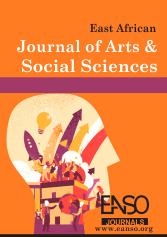Family Socio-Economic Background and Girls Education in Public Secondary Schools in Bungoma County, Kenya
Abstract
The paper presents a discussion on the influence of family socioeconomic background on investment in girls’ education in public secondary schools in Bungoma County. Despite several measures to enhance gender parity in the transition of students to secondary school, disparities still persist among girls. The paper focuses on key socioeconomic aspects like parents' level of education, family size and household income and how they influence the investment in girls' education at secondary school. A descriptive survey design was adopted in the study. The target population for the study was 242 parents, 245 students, 148 teachers and 60 head teachers. 91 parents, 108 teachers, 36 headteachers, and 172 students were sampled using simple random sampling. Data was obtained using interview schedule for parents and structured questionnaires. Qualitative data was analysed thematically to identify key patterns and themes that are related to perception and challenges related to investment in girl’s education, quantitative data was coded, formatted and analysed using Social Package for Statistical Science (SPSS). The presentation of the findings was done using pie charts, tables and graphs. The findings established that parents’ level of education had a significant influence on their attitude towards girls' education. Highly educated parents prioritized the investment in girl’s education as compared to those with lower level of education. The study also established that family size and household income also impact the investment in girl’s education since parents with large families are more likely to struggle to allocate the limited resources toward their children education with girls being the most disadvantaged gender. The paper highlights the need to sensitize parents and the community on the significance of investing in girl's education, Initiating income generating programmes for low-income households should be adopted to alleviate their financial constraints. In addition, parents should also be sensitized to have few children.
Downloads
References
Buchmann, C., & Hannum, E. (2011). “Education and Stratification in Developing Countries: A Review of Theories and Research.” Annual Review of Sociology, 27(1)
Glick, P., & Sahn, D.E. (2020) Parental education and the gender gap in schooling: Evidence from Africa. Journal of African Studies, 45(3), 245-261.
Kerlinger F.N (1973) Multiple Regression in Behavioural Research. Holts, Reinhurt and Winston. New York
Ketija, M. (2018) Socioeconomic factors determing children dropout rates in Babati Town Council, Tanzania. African Journal of Educational Studies in Mathematics and Sciences, 14(1), 1-2
Kilonzo, A, & Wambua, T. (2018). The impact of family size on education: A gender perspective in Kenya. Nairobi: African Jounal of Education Studies. 6(3), 21-27
Mackatiani, C., Mackatiani, N. I., & Owino, M. A. (2022) Transition in education: Perspectives on girl’s dropout rate in secondary schools in Kenya. International Journal of Educational Research and Development, 10(2), 45-58
Musau. K.H (2017). Socioeconomic Determinant on the Investment in Girls Secondary School education in Machakos County. Unpublished M.ed Thesis, Machakos University
Nyanga, S. (2019) Cultural determinants of gender disparities in education: Case of Bungoma County. African Journal of Gender Studies, 12(2), 123-135.
Otieno, P.A (2013). Factors that influence the Retention of female students in secondary schools in Busia County. Unpublished M.ed Thesis, University of Nairobi
Patel, V., Adhikari, S., & Mehta, R. (2018) Household education status and girl’s dropout rates in India: The significance of maternal education. Journal of Social Issues, 74(1), 119-137
Smith, L., Jones, R., & Thompson, K. (2022). The impact of household income on secondary school dropout rates among girls in Australia: A mixed method approach. Australian Journal of Educational Research, 66(3), 389-407
UNESCO. (2020) Education for all: Addressing gender disparities in education. Paris: UNESCO
Copyright (c) 2025 Wechuli Simiyu Christopher, Sarah Naliaka Likoko, PhD

This work is licensed under a Creative Commons Attribution 4.0 International License.




























